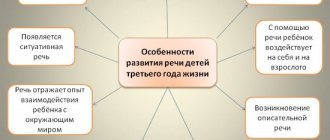Speech is a form of communication between people using linguistic structures. When a child is born, he does not know how to do anything and the task of an adult is to teach him everything. Teach to walk, hold a spoon, a mug, go to the potty and talk. While everything else is more or less clear, parents always have a lot of questions regarding speech. What to do if the child does not speak? If he speaks “his” language? And many, many different questions. Today we’ll talk about speech development, speech delays, examinations and more.
About speech understanding
Speech understanding is one of the criteria for assessing a child’s speech, and no less important. The child may not speak, but can fully understand speech.
Speech comprehension should also be age-appropriate.
How to determine that a child understands speech?
The assessment of the speech understanding criterion occurs at 1 month of the child’s life.
- At 1 month, the baby flinches from a voice or sound.
- At 2 months, expresses anxiety about sounds or voices.
- At 3 months, looks at the speaker.
- At 4 months, he turns his head towards the speaker and stops crying when he is reassured by speech.
- At 5 months he begins to respond to his name, but this is only if he was previously addressed by name, and not just “baby”, “bunny” and so on, otherwise he will respond to the baby and the bunny.
- At 6 months he stops when he hears the word “no” and begins to use gestures. This does not mean that the child understands what you mean by “no.” Gestures are one way of speaking, for example, when a baby reaches out to be picked up.
- At 7 months, looks at a familiar object when it is named. Use question designs like: “Where is the bird?” Where's dad? We also teach the concept no: “Where is the bird?” - the child looks at the sky - “there is no bird.” And we show our heads no. At 7 months, the child realizes where he is; to do this, we bring him to the mirror, look at him and show him, calling him by name.
By the age of one year, a child’s vocabulary is 5-9 words, of course, it can be more. These words do not appear immediately at 12 months, but gradually. The first words can appear at 6-7 months, such as “whoa - cat”, “bang - fell”, “ss - chest” and the like. If all this is missing, it is too early to talk about delayed speech development, check your hearing and continue to develop and educate your baby.
There may be not a single word at all, and this will also be a variant of the norm, since the assessment is also determined by the understanding of speech.
It is not normal if per year:
- no babble
- does not point to the object
- does not use gestures.
You can't tell a child
- I don't understand you,
- what are you whispering there?
- speak louder and clearer!
The child should know that you always understand him, even without words.
If the child’s speech level does not correspond to the norm, most likely he was not taught and this is also a variant of the norm. It is possible to train.
The reasons for the lack of speech may be more serious
Another important point is the fact that undeveloped speech at the age of 4-5 years may be a manifestation of certain psychological or neurological disorders. This is a reason not only to read books with your child more often, but also to use the help of qualified specialists. Among the causes of speech delay, in addition to physiological lag, mental disorders can also be identified:
- Stress. A strong shock experienced by a child can completely stop the development of speech. Only a specialist can talk to him, and the risk of stuttering due to fear is very high.
- A difficult psychological atmosphere at home can also lead to speech delays.
- Delayed psychomotor and mental development, accordingly, inhibits the formation of speech skills. Therefore, it is extremely important to monitor the child, especially those who speak poorly.
- A separate important point should be highlighted neurological causes as a result of a difficult pregnancy or difficult childbirth, head injuries, or even simply too frequent falls of the child. Experts, based on observations, have concluded that in more than 50% of cases, delayed speech formation is a consequence of MMD (minimal cerebral dysfunction).
Why doesn't he speak?
In fact, “does not speak” is a rather loose concept. Let's give examples.
- The child does not utter any words at all, not even “yes” and “no.” For a 1.5 year old this is normal, but for a 4 year old child this is already a problem.
- Doesn't speak sentences. For 2.5 years it will be the norm. At 4 years old you already need to worry.
- The child understands spoken speech, fulfills requests and instructions, regardless of complexity, but does not speak.
- The child talks a lot, but in “his” language.
- The child speaks, but those around him do not understand him, because he replaces many sounds.
That is, in each situation the concept of “does not speak” will be different. And here it is important to understand the reason, find an approach and correct it. In some cases, it is possible to involve more specialized specialists.
It is important to understand that in the process of speech formation, understanding it is more important than pronunciation.
Functional dyslalia
If the speech apparatus is in order, but there are problems with sounds, functional dyslalia is evident.
Causes of functional dyslalia:
- Incorrect speech patterns. Sometimes parents (grandmothers, aunties, teachers) literally begin to lisp with the child, repeating their incorrect pronunciation, which is fixed in the child’s memory and is subsequently regularly reproduced.
- It often happens when a well-spoken child begins to go to kindergarten with children who are less developed in terms of speech, then regression may be observed in his speech - learned sounds, and even entire words and phrases, disappear. In some cases, parents themselves have speech defects and cannot pronounce words correctly and clearly. In this case, children also have difficulty establishing correct pronunciation;
- In children with early learning of a foreign language, the phonetic features of the two languages are mixed, and the child pronounces sounds in Russian words that are characteristic of other languages;
- “Pedagogical neglect”, when the child is not corrected, mistakes in his speech go unnoticed
To correct the disorders caused by functional dyslalia, the child needs to hear correct, clear speech as often as possible. If the parents themselves do not speak clearly, then the child must have an appropriate environment - other adults, a speech therapist. In this case, it is good to listen to audio tales and poems recorded by professional actors, whose diction can be considered a model. A speech therapist can select a more accurate speech correction program.
A child with speech underdevelopment should be in a rich speech environment, filled not with the sounds of a working TV, but with beautiful, correct and clear words and sentences from adults.
What to do if he doesn't speak?
- Do not put pressure on the child.
- Constantly provide information to the child.
- Communicate with your child on any topic.
- Do not lisp and pronounce words clearly.
If the baby does not speak at all or does it poorly, there is no need to constantly ask him to say something, especially contact him with the word “tell.” Most likely the child cannot say something and hardly wants to. That is, he wants to, but he can’t.
It is important to remember that:
- Some walks, starting from 3-4 months, should be in the wakefulness interval.
- An adult should comment on some of the actions, but not like a radio, but if he were telling a 3-4 year old child. For example: “Let’s go have lunch and then go for a walk.”
- From birth we conduct a DIALOGUE with the child, not a monologue. That is, we give a pause and wait for an answer from the child, even if this does not happen. Someday he will definitely answer, be patient.
The most important thing is to praise the child if he himself simply uttered a word, sound or syllable, even if there are mistakes and it is not clear, he is still doing well because he is trying. It is also important to maintain a conversation when a child tells you something, even in his own childish language, but he must see feedback, interest, that mom and dad understand him, even if this is not the case. "Wow! Is it true? That's the story!" - this will be enough for a wave to maintain a conversation with the baby.
What is ZRR and how does it manifest itself?
SRD is a delay in speech development. In order to suspect that a child has a developmental disorder, certain signs must be present.
- At 12 months: little babbling, the child is quiet.
- At 18 months: does not understand his own name, the names of surrounding objects, or the calls “come here”, “sit down”.
- At 2 years old: uses individual words in a limited number, does not try to repeat words.
- At 2.5 years: does not know the names of body parts, environmental objects; upon request, cannot name an object or bring something within sight; cannot form simple two-word phrases, for example, “I’m hungry.” Often the child is misunderstood.
- At 3 years old: does not speak simple sentences (subject, predicate, object), does not understand simple explanations or stories about events in the past or future.
It is worth noting that a significant delay in speech development is typical for children with general developmental delay.
That is, in most cases, the fact that a child does not speak does not mean the presence of SDD.
The diagnosis of SDD can be temporary, for example, when a child at 2 years old speaks less than 50 words. This diagnosis will be temporary and means that a healthy child has minor speech problems and all that is needed is to talk to the child more.
Hardware examinations for speech delay
To diagnose the disorder, it is important to conduct hardware examinations (very often neurologists neglect them, so parents can conduct them on their own initiative):
- Dopplerography of the vessels of the neck and head. It has been statistically proven that with motor alalia, problems with cerebral circulation (for example, venous congestion) are common. That is, the brain does not have enough nutrition. To exclude this factor, it is necessary to conduct a study, and based on the results, the neurologist will prescribe therapy if necessary. Usually, if there are such problems, treatment includes manual therapy - massage, osteopathy, as well as hirudotherapy, sometimes diuretics (to reduce ICP), etc.
- EEG – electroencephalogram . This study shows the level of maturity of the cerebral cortex by measuring its bioelectrical activity. As a rule, it does not provide a clear understanding of structural disorders, but it allows one to exclude epileptiform activity, paroxysmal activity and identify the most noticeable pathologies. For example, a violation of electrogenesis in the area of stem structures is often detected, which helps in making a so-called topical diagnosis.
- Evoked potentials. This examination can be performed separately on different sensory systems. For those who don't talk, I recommend doing ASEPs (acoustic brainstem evoked potentials), CSEPs (cortical auditory evoked potentials), and CEPs or P300s (cognitive evoked potentials). In different clinics they are done a little differently, but the main task of the research is solved perfectly everywhere: it is necessary to study the quality of processing of the auditory impulse at the subcortical and cortical level. This is NOT a hearing test. Physiological hearing may be normal, but the child may not understand spoken speech (speech auditory agnosia/sensorimotor alalia). Even with the understanding of speech preserved at first glance (“understands everything, but does not speak”), disturbances in the conduction of auditory impulses are often detected, as well as signs of structural subcortical dysfunctions (often the brain stem, cerebellum).
- MRI. Many parents are afraid to give their little child an MRI because... supposedly it is done under anesthesia. It is necessary to distinguish between anesthesia and sedation, that is, drug-induced sleep. These are different things. Sedation is not traumatic for the nervous system. Often you can do without this examination, but in some cases it may be necessary to clarify the diagnosis. Magnetic resonance imaging is very informative and accurate.
Who needs examinations?
Examinations are needed if the doctor suspects a child has speech development delay (SDD). Not all children who do not speak have this delay and not all children need testing.
If RRR is still suspected, then the following examinations are necessary.
- Examination by a pediatrician.
- Examination by a neurologist.
- Examination by a psychiatrist (included in the medical examination of children 2 years old).
Research carried out according to indications.
- Electroencephalogram (EEG and sleep monitoring. In very rare cases, a child experiences developmental regression and this is associated with a large amount of epiactivity on the EEG during sleep, when the child does not have epileptic seizures.
- MRI.
- Genetic tests.
- Examination by an audiologist, audiometry,
- Acoustic Spectrum Disorder Test.
Mechanical dyslalia
Mechanical or organic dyslalia is caused by structural features of the speech apparatus, such as:
- shortened frenulum of the tongue;
- thick and large tongue;
- small and narrow tongue;
- high narrow (Gothic) or, on the contrary, too low palate;
- malocclusion, in which the sound formation of individual phonemes becomes difficult or, in some cases, even impossible;
- an upper or lower jaw that is too forward, a gap between the teeth or between the jaws;
- sometimes the inability to pronounce sounds is also influenced by the weakness of the air stream necessary for the formation of sounds that are especially difficult for children - r and l.
Most often, with mechanical dyslalia, the speech therapist recommends that the bite be corrected by an orthodontist, if possible. This is best done at the age of 5-6 years, when the joints are most flexible.










